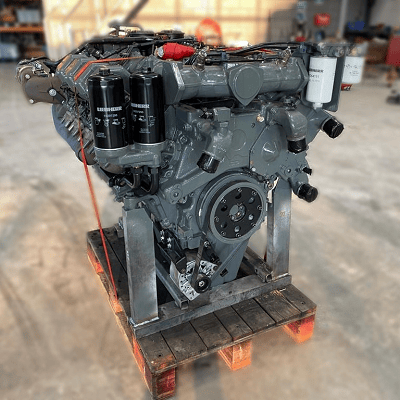The process of a dyno test on a Liebherr engine

When it comes to heavy machinery, reliability and power are paramount. Liebherr, a name synonymous with innovation and excellence in engineering, stands tall as a pioneer in the realm of heavy Equipment and machinery. From towering cranes to robust excavators, Liebherr’s engineering prowess extends to the heart of these machines. We delve into the world of dyno testing a Liebherr engine, uncovering the meticulous process behind unleashing the raw power concealed within.
The foundation of excellence
Before we embark on the journey of dyno testing, it’s crucial to understand the foundation upon which Liebherr engines are built. With decades of engineering expertise and commitment to quality, Liebherr engines are crafted to withstand the most demanding environment and deliver unparalleled performance. Each component is meticulously designed and rigorously tested to ensure reliability, efficiency and longevity.
The process
1 Preparation: The engine undergoes meticulous preparation before being mounted onto the dynamo meter. This includes ensuring all connections are secure, fluids are filled to the appropriate levels, and sensors are properly calibrated.
2 Mounting: The engine is carefully mounted onto the dynamometer, a specialized device designed to simulate real-world operating conditions. Precision is paramount during this step to ensure accurate results.
3 Initial checks: Once mounted, a series of initial checks are conducted to verify proper alignment, connection integrity, and functionality of all engine systems.
4 Warm-up: The engine is started and allowed to warm up to operating temperature. This ensures consistent results and minimizes the risk of damage during testing.
5 Baseline testing: With the engine warmed up , baseline tests are conducted to establish initial performance metrics. This includes measuring power output, torque, fuel consumption, and emissions at various RPM levels.
6 Load testing: The engine is subjected to progressively increasing loads to simulate different operating conditions, such as idle, partial load and full load. This allows engineers to assess performance across the entire operating range and identify any potential issues or optimization.
7 Data analysis: Throughout the testing process, data is continuously collected and analyzed in real-time. Advanced instrumentation and software are used to monitor performance metrics and identify trends or anomalies.
8 Optimazation: Based on the data analysis, adjustments may be made to optimize engine performance. This could involve fine-tuning fuel injection timing, adjusting air-fuel ratios, or optimize turbocharger boost pressure.
9 Validation: Once testing is complete, the results are meticulously reviewed and validated against predetermined criteria and specifications. Any deviations or anomalies are thoroughly investigated to ensure accuracy and reliability.
10 Reporting: Finally, a comprehensive report is generated detailing the results of the dyno testing, including performance metrics, observations, and any recommendations for further optimization or refinement.
The outcome of dyno testing
Dyno testing a Liebherr engine is more than just a routine procedure – it’s a testament to the unwavering commitment to excellence that defines Liebherr’s engineering philosophy. By subjecting their engines to rigorous testing and analysis, Liebherr ensures that each engine delivers the uncompromising performance, reliability, and efficiency that customers expect.
In conclusion, dyno testing a Liebherr engine is not just about measuring power output. It’s about unlocking the true potential of these remarkable engines and ensuring they exceed expectations in the most challenging environments imaginable.
Hot Melt Adhesive For Paper Packaging
Shipping cartons must be able to withstand temperature, humidity changes and rough handling, but the use of tape is more difficult to meet this requirement, because of its poor bonding strength, low tensile strength, and for coated or oily cardboard is not strong.
The hot melt adhesive has a good bonding force with the wet material, strong penetration, and plays a physical and chemical bonding role between the corrugated paper and the lined paper board. The overall strength of the carton after bonding is enhanced, and the carton is not easy to deform and crack. In addition, the hot melt adhesive coating system can be applied to a variety of different shapes of the key parts, such as: carton folding lid.
Second, the low temperature resistance of the self-adhesive tape is poor, in the cold climate in the north, easy to open the glue; Hot melt adhesive has good low temperature resistance, can withstand -40℃ low temperature. Moreover, the storage period of hot melt adhesive is up to 2 years, the storage area is small, and there is no special storage requirements; The validity period of tape storage is only half a year, and certain storage conditions are also required, otherwise it is easy to deteriorate.
Hot melt adhesive also provides a good anti-theft function, as the adhesive penetrates into the corrugated, any attempt to open the carton will tear the fibers. The tape can be cut with a knife, unknowingly removing the contents and sealing them again.
Hot Melt Adhesive For Paper Packaging,Adhesive Hot Melt Glue,Hot Melt Glue Books Binding,Adhesive For Book Binding
Shenzhen Tongde New Materials Technology Co., Ltd. , https://www.tdhotmeltglue.com